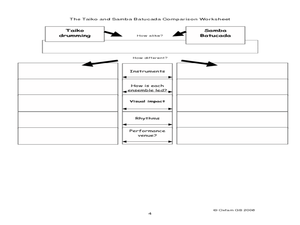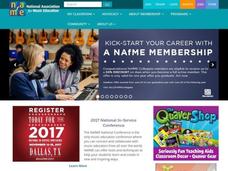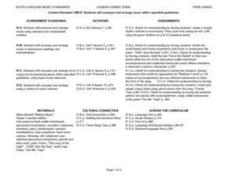Curated OER
Timbre: Identifying the Tone Color of the Saxophone
Young scholars explore the concept of timbre. In this timbre lesson, students experience timbres produced by saxophones in contemporary music. Young scholars explore the science behind the music.
Curated OER
Musical Instrument Families
Using graphics, and an easy-to-understand format, this resource outlines the different kinds of instruments and their characteristics. This presentation could be used as an introduction to instruments for students getting ready to...
Curated OER
Tone Poem Composing Project
Students explore role of music in storytelling by watching and discussing effect music has on perception of scene from movie, and using Sibelius program to compose single excerpt of music, considering dynamics, timbre, and articulation,...
Curated OER
Timbre Activities
Young scholars investigate the concept of timbre. In this music activity, students listen to several recordings of musical pieces and identify the name of the instrument playing with its picture.
Curated OER
What is Timbre?
Students analyze the differences in similar songs. In this music appreciation instructional activity, students discover the meaning of timbre and how it can drastically change similar pieces of music. Students sing two pieces of music...
Curated OER
Investigation of Timbre
Students design an experiment to analyze the timbre of different instruments. For this physics lesson, students analyze the missing quality in sound. They discuss their results in class.
Curated OER
Changes of Musical Elements in Popular Music Through the Decades
Students probe samples of European classical, American jazz, and rock and roll to analyze the similarities and differences. The styles and form of these three types of music are examined for tempo, timbre, and rhythm.
Curated OER
Music in Other Cultures
High schoolers examine the musical concepts of timbre, melody, and rhythm. They listen to and identify characteristics of music from other cultures.
Curated OER
Pavane pour une Infante Defunte
Students describe the music in terms related to basic elements such as melody, rhythm, harmony, dynamics, timbre, form, style, etc. They identify timbres heard in "Pavane" by movement and respond by movement to timbre.
Curated OER
Polyrhythmic Drumming Styles: Japan and Brazil
Students explore cyclic patterns in drumming style. In this multicultural music lesson, students listen to and compare Taiko and Samba drumming styles and complete a compare/contrast worksheet.
Curated OER
Accomplished Practice # 10
Fourth graders performs on instruments in an ensemble, maintaining a common tempo, blending instrumental timbres, and matching dynamic levels. They respond to the tempo and dynamics cues of the conductor.
Classics for Kids
"Mars" from The Planets
Gustav Holst's The Planets provide young musicians an opportunity to examine how composers can create a suite: a collection of smaller pieces grouped to explore a single topic. After listening to "Jupiter," they examine "Mars" in detail,...
California Department of Education
Waves and Music
Strike the right chord with a musical activity! Instructors provide a lecture on the mechanics of a pan flute. Pupils build their own pan flutes by using straws and calculating the lengths to create a scale. After cutting the straws to...
Curated OER
Comet And Rain Timbres
Second graders engage in a lesson that uses folk instruments in an accompaniment while listening to a song about a comet. They make a cross-curricular connection to Halley's Comet. Students discuss the qualities of a singer-songwriter.
Curated OER
"Nutcracker"
Students recognize the timbre of a celesta by listening to music that contains the celesta. They listen to music from Tchaikovsky's "Danse de la Fee-Dragee" (Dance of the Sugar-Plum Fairies), track #14 and describe how the music...
Curated OER
Antonio Vivaldi-The Four Seasons
Second graders uncover the form, timbre, and the significance of Vivaldi's "The Four Seasons" in the five lessons of this unit. The use of instrumentation forms the basis of the lessons.
Curated OER
Meet the Instrument Families
Fourth graders listen to a recording of a string quartet and ask questions about what kinds of instrument they think they are listening to and describe what they think the instruments look like. Then they discuss musical ideas such as...
Curated OER
Fifty States In Rhyme
Students perform "Fifty States in Rhyme" with correct posture, correct rhythms, and accurate pitches. They also identify and perform such musical terms as tone color, tempo, dynamics, phrases, and accents. Emphasis is placed on the...
Curated OER
Exploring Musical Instruments of the Orchestra
Students listen to "The William Tell Overture," identify instruments, sounds and other characteristics of the music. They compare and contrast orchestra music to large band music. Students discuss the musical composition and how the...
Curated OER
Lesson Connections
Third graders sing alone, with others and practice a varied repertoire of music. They have to sing using appropriate timbre, diction, and pesture, all while maintaining a steady tempo. Singly expressively, with appropriate dynamics,...
Hawaiʻi State Department of Education
Fuzzy Wuzzy
You don't need drums to play percussion; you can use your own body. Second graders use body percussion to make four-beat rhythms and play patterned clapping games. When they are finished they discuss beats, patterns, rhythm, and rhyme.
Curated OER
Music and Animation: 200 Greatest Pop Culture Icons
Music has been used to convey thoughts, feelings, and the human condition for thousands of years. Your class will analyze several songs hear in the animated classic, "Charlie Brown." They will listen to several jazz pieces from the show,...
Curated OER
Singing a round
Kids use their hands, bodies, and voices to explore the musical concept of a round. They say vegetable words while stomping and clapping out a rhythm in unison and then in a round. They then sing a round while maintaining a steady beat....
Curated OER
GCSE Notes 2000: Classical Music
Classical period music is defined by its characteristics and distinctive sound. A set of notes assists upper graders in recalling and analyzing music from the classical period based on musical terminology. An example analysis of Eine...
Other popular searches
- Teaching Timbre
- Music Timbre
- Vocal Timbre
- Music Lessons on Timbre
- Timbre Percussion
- Instrumental Timbres
- Music Lessons: Timbre
- Timbre Instruments
- Lessons on Timbre
- Music Lessons Timbre
- Teaching Timbre to Children
- Music Timbre Differences

























